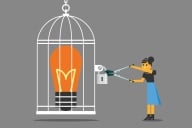You have /5 articles left.
Sign up for a free account or log in.

Getty Images
College students likely spend hundreds of thousands of dollars extra per year on buying rights for digital versions of readings to which they have free access.
Some college and university libraries have been attempting to rein in the duplicative charges, which stem from journal articles and other assigned readings that students are told to buy for class even though the material is freely available to them through library holdings.
Stanford University, for instance, found that more than $100,000 was being spent, mostly by students, on course materials that could be found in the 1,200 databases the university spends millions of dollars to make available.
This is because faculty and students are often unaware of what is already available.
“The hurdles to knowing what we have are high,” said Catherine Tierney, Stanford’s associate university librarian for technical services, “so that the T.A.s or the department admins or the faculty person herself doesn’t even know what we have. So it’s inadvertent double-spending on this.”
Tierney said the Stanford analyzed its own records from July 2010 to June 2011. About 60 percent of the course materials the university sought to license from the Copyright Clearance Center for student coursepacks was already among Stanford’s library holdings.
Around the same time, the university was developing an in-house software program to automate copyright clearance. The product, known as the Stanford Intellectual Property Exchange, was an effort to “massively reduce legal transaction costs for intellectual property exchanges.”
The university has since turned the effort into a spinoff, known as SIPX. The company announced last week it had received $4 million in a new round of venture capital that includes money from Stanford. The company is seeking to expand through a series of university-level agreements across the country, said CEO Bob Weinschenk. Its customers already include Empire State College of the State University of New York, a pilot project at the University of Illinois and, of course, Stanford. It is also trying to work with institutions that offer massive open online courses through Coursera and edX.
It allows faculty to compile digital reading lists. It can check to see what readings are freely available, which would prevent the sort of inadvertent double-spending that Stanford found. It will also automate the purchase of individual texts from a variety of publishers that do require new licenses to use in class.
Beth Clausen, head of access services at the Northwestern University Library, is looking at SIPX in part because of double-spending issues she found when she compared the material in assigned coursepacks to the material the university has in its digital holdings. She said she's found some faculty are putting together coursepacks for students to buy that are made up entirely of material students could get for free -- though other coursepacks contain no such material.
The center’s president and CEO Tracey Armstrong said in a statement, “Companies like SIPX can go directly to publishers, through CCC, or both for copyright clearance. We appreciate SIPX and their customers’ respect for intellectual property.”
Weinschenk pitches SIPX’s as an easy way for universities to get their arms around their holdings and for faculty to see if the material they are trying to use is already available. If a university doesn’t have the material, Weinschenk said SIPX will locate the article and get a price for it that students will then pay. SIPX plans to make money from a transaction fee on those purchases.
Other universities have decided they can reduce costs without turning to outside companies. Cornell University realized a decade ago it was asking students to pay more than they needed to. University officials decided to have its bookstore and library work together to review licensing agreements to see if the university could reduce coursepack costs. The partnership immediately saved $34,000 in one semester.
Peter Hirtle, a senior policy advisor at the Cornell library, said the homegrown solution worked just fine. “I’m not sure having an automated system to do it would help us,” he said.
Hirtle worries that if more universities are able to find savings they will only incite publishers to raise their prices.
He is also curious about the legal implications of efforts to create reading lists designed to work like coursepacks because publishers’ licensing agreements with libraries often have clauses designed to prevent material from being turned into a coursepack.
SIPX makes a distinction between what it does, which focuses on making available a reading list of individual texts, and a coursepack, which bundles works together in a single file.
The University of Minnesota-Twin Cities has been working for several years to get a better handle on copyright clearance in an effort to lower costs for students and comply with copyright laws.
Nancy Sims, Minnesota’s copyright program librarian, said SIPX approached the university about a business relationship.
“We looked at it. It didn’t seem like quite the right fit for us,” she said. “We were already working on similar type solutions, and we are working on better ways to deliver course reading contents to students in formats they want.”
Sims said the university’s various departments – its library, its university-operated bookstore and its copyright permission’s office – are working together to handle copyright and course material issues.
For instance, Minnesota found that students were more likely to be asked to pay for holdings they could be getting for free if the professor first went to the copyright permission center instead of the library. That prompted officials to try to make sure faculty were able to have a good idea of what was already among the university’s holdings before they sought a license. “In the last few years we’ve been working hard between the libraries and the permission center to make sure those processes are more consistent,” Sims said.
Hirtle and Sims also emphasized that fair use applies to some classroom activities. It’s unclear, Hirtle said, if an automated system designed to make licensing easy would cause faculty to forget about fair use, which would be far cheaper than any licensing arrangement.
SIPX has formed partnerships with a number of publishers, including Elsevier. One of Weinschenk’s goals is to produce data for both universities and publishers that will help them make wiser decisions about purchases and pricing.
Tierney said Stanford could use that data to see what databases are used. That, in turn, could be a factor in deciding whether the university will continue to pay for its use – but only one factor. “Sometimes you have to buy it anyway even if two faculty members are using it,” she said.
An Elsevier executive who has worked with SIPX did not return a call to talk about his company’s view of the partnership.
In a product demonstration of SIPX this week, company officials showed a way to rapidly compile a list of readings. Each article is available for individual or joint purchase, so students can decide what to take or leave. The material comes in the form of PDFs, which can be used on nearly any device and can be printed.
The software is designed to work within a learning management system and require only one login. Weinschenk said this could increase the consumption of digital courseware.
“A student given a list of 10 reading items, would they go to four or five or ten portals and consume there?” he said.
AcademicPub, which focuses on printing coursepacks, also rolled out a feature earlier this year that allows faculty to look at colleges' digital access rights as they prepare coursepacks. The software is slightly different, though, because it compares digital access rights to the eight million pieces of content AcademicPub has already cleared to use in coursepacks.
Caroline Vanderlip, the CEO of AcademicPub’s parent company, said the feature was added because of demand by librarians.
“They are rightfully proud of all of those licenses and the expansiveness of all of the materials,” she said. “They’ve got the expertise to know what exists, but what they were missing is the ability to transfer that to the faculty and ultimately to the student.”
Vanderlip bets that coursepacks and not lists of articles like SIPX makes available are what students are looking for. About 75 percent of AcademicPub’s coursepacks are sold as print volumes.
While SIPX reading lists could theoretically be free if libraries owned all the rights to the material, AcademicPub charges at least $6.95 to bundle content, plus printing costs. AcademicPub’s software, Custom College Plus, is free to colleges, while SIPX charges institutions a fee.








